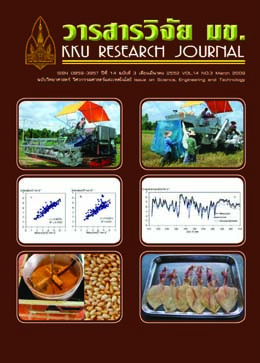Simple model for estimation of evapotranspiration from rainfed lowland rice (Thai)
Main Article Content
Abstract
Rice is an important crop for Thailand, but its yield is low partly due to limited water availability. As water demands by various sectors continually increase, any yield improvement has to be considered in parallel with that of water use efficiency. Analysis to find options for better yield and water use efficiency inevitably involves estimation of evapotranspiration for which the Penman-Monteith equation has been widely used. However, the unavailability of complete local weather data has largely restricted its application. Preliminary analysis of the paddy environment suggests that environmental variables other than solar radiation tend to be stable, and hence lead to the hypothesis that evapotranspiration could be related linearly to solar radiation. If true, it can be used to extend the estimation of evapotranspiration to cover a greater area. Therefore, measurements of evapotranspiration using Bowen Ration Energy Balance, solar radiation and other environments of the paddy were made in Khon Kaen and Roiet Provinces during 2006 to obtain data to test the hypothesis. The results indicate that the evapotranspirational rate can be described as a linear function of solar radiation, and the linear approximation had accuracy comparable to that of the Penman-Monteith equation.


